Impact of the Professional Capacity Building for Communications Project
WSRTC HOME | IMPACT HOME | WSRTTIF IMPACT | PCB IMPACT | OSS IMPACT | PCB HOME
Professional Capacity Building for Communications (PCB)
The Professional Capacity Building for Communications project is designed to address a knowledge gap in Rural ITS communications - rural ITS engineers may lack the critical skills necessary for designing and maintaining reliable and robust communication networks for rural ITS field equipment. A curriculum has been developed that focuses on understanding the various communication technologies available and how to best select and implement these technologies, particularly in a rural environment.
The main objective of the project is to have subject matter experts provide practical, nuts and bolts training to rural ITS engineers and technicians. To that end, five week-long training courses have been provided to Caltrans engineers. The first one dealt with the basics of RF System Design. The second one covered Optical Fiber and the third addressed IP Networking Fundamentals and Usage. A fourth training covered the subject of Telco Wireless Communications. A fifth course examined Small Data Center Design as Related to Transportation Management Centers (TMCs) with a focus on structured cabling and grounding.
PCB for Communications Training:

Photo by Doug Galarus |
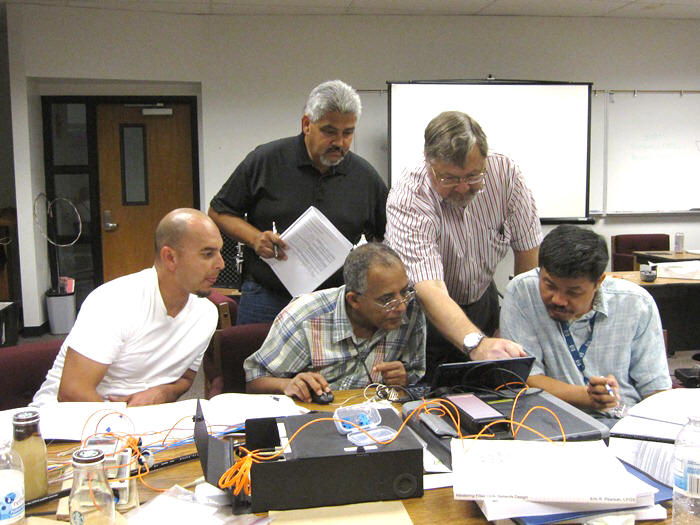
Photo by Leann Koon |
Radio Frequency System Design
The Radio Frequency (RF) System Design course taught design engineers and technicians the key elements needed for designing
RF communications systems. During the 4-day course, students learned about basic radio principles, antenna systems, transmitters, receivers, and cables. Area coverage systems, radio test equipment, and conformance and delivery rounded out the discussion and steps to designing and engineering RF links and systems. The training course was geared towards rural ITS engineers and students primarily came from Caltrans districts that work with rural transportation challenges on a regular basis. To read more about the RF System Design training course, see the November 4th, 2010 PCB Project update.
Optical Fiber
The Optical Fiber Course was an intense, 5 full days of training covering design of fiber optic networks, and
installation, maintenance, and testing of installed networks. By design, the course included lectures as well as a significant amount of time spent working
on laboratory exercises and hands-on problems. In order to make the course as realistic and practical as
possible, students were encouraged to bring their own equipment to use during the class. To read more about the Optical Fiber training course, see the November 7th, 2012 PCB Project update.
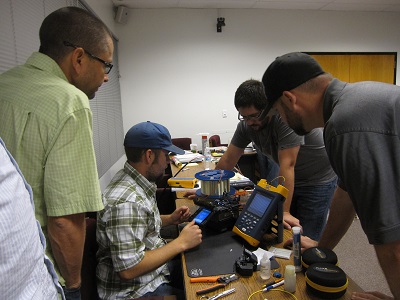
Photo by Leann Koon |
IP Networking Fundamentals
The fundamentals of IP networking and usage are critical skills for ITS engineers. The IP Fundamentals course focused on the systems engineering approach to Ethernet and IP networking with a combination of knowledge training and systems analysis. Understanding IP Networks, Local Area Networks (LANs), and Wide Area Networks (WANs) were the main subjects of the course. Practical exercises that were relevant to students’ jobs were an important component of the training. You can read more about the IP Networking Fundamentals and Usage training course in the November 12th, 2013 PCB Project update.
Telco Wireless
Leased wireless communications systems are being considered as a cost-effective, viable solution for more rural ITS deployments. The Telco wireless fundamentals and usage course was designed to give Caltrans’ ITS engineers an understanding of the design principles and practical application techniques involved with using these technologies for ITS implementations. The course reviewed the various wireless access technologies and their evolution, network architectures, how they operate, and different factors that affect them. With a focus on LTE, sections on cellular RF engineering, planning, design, testing and optimization brought everything together. Find out more about the Telco Wireless course in the April 6th, 2015 PCB Project update.
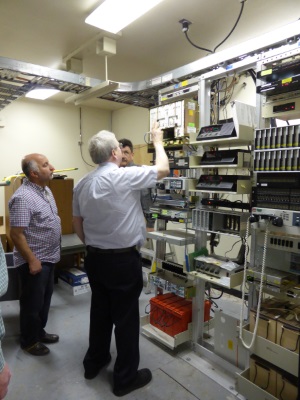
Photo by Leann Koon |
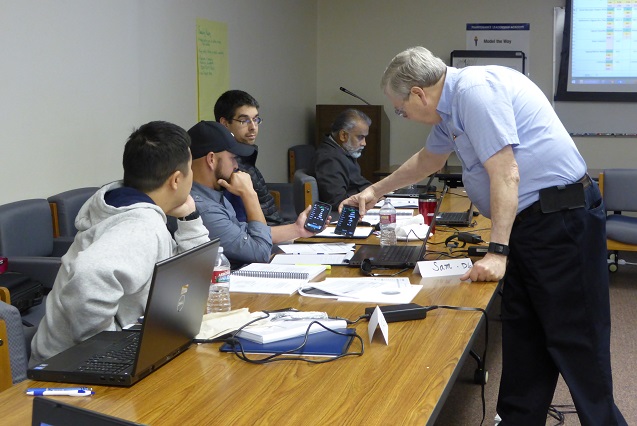
Photo by Leann Koon |
Small Data Center Design, Structured Cabling, and Grounding
TMCs collect and process data from ITS field elements. That data can be used to make decisions and implement management strategies. The TMC also disseminates traveler information to the public. How all of this is accomplished involves many variables, systems, and sub-systems, and varies considerably depending on the specific purpose of the TMC. With that said, there are several concepts and competencies related to small data centers and TMCs that Caltrans ITS engineers should possess and be able to effectively implement. This formed the basis for the course’s content and guided its development.
The course was a full five-day (40 hours), engineering intensive training with a high level of technical detail. Students learned some of the fundamental elements of an effective design for a new TMC data center as well as for upgrading and retrofitting an existing TMC. Structured cabling and grounding as related to TMC data centers were focus points of the course. Lab exercises included evaluating multiple structured cabling designs to address various network architectures and topologies, designing a new TMC data center, as well as retrofitting and upgrading an existing TMC. The PCB project update from July 23rd, 2019, has photos and more details about the training course.
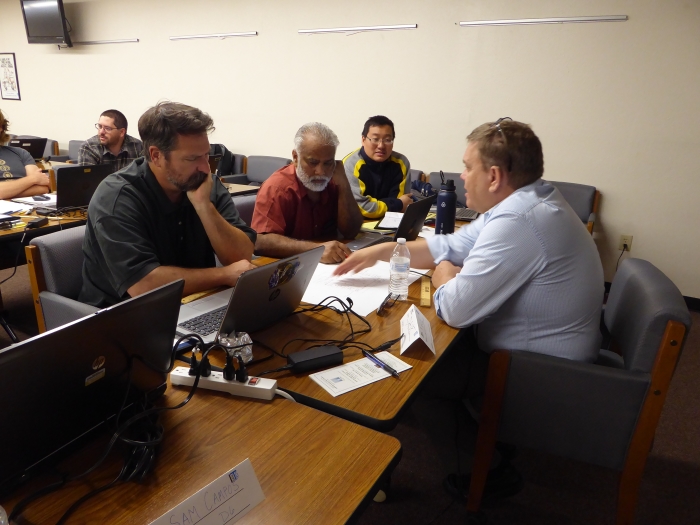
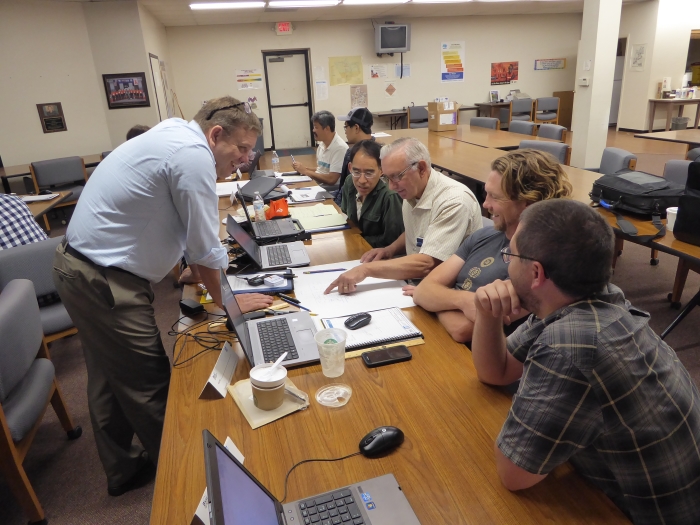
Photos by Leann Koon
Radio Frequency (RF) Fundamentals Training
Plant wireless communication, as applied to Rural ITS, consists of systems that are user owned and installed. Basic knowledge of radio frequency communication is necessary for designing and building successful wireless communication links. For example, with the availability of the 4.9 GHz Public Safety band, RF systems may be an important way to connect multiple ITS field elements to a Transportation Management Center (TMC).
This highly technical course included 40 hours of training delivered over five days. Each day, instruction was tailored specifically to the needs of rural transportation engineers and the ITS challenges they encounter. Students learned fundamental knowledge for microwave communications including how to calculate link budgets and system losses, optimize radio system coverage using propagation analysis tools, perform and interpret RF system measurements, and maintain and repair equipment. Lab exercises included a microwave radio configuration lab, coax cable connector lab, microwave radio data transport lab, and microwave system management lab. Check out the PCB project update from November 2nd, 2023, for a few photos and more details about this training course.
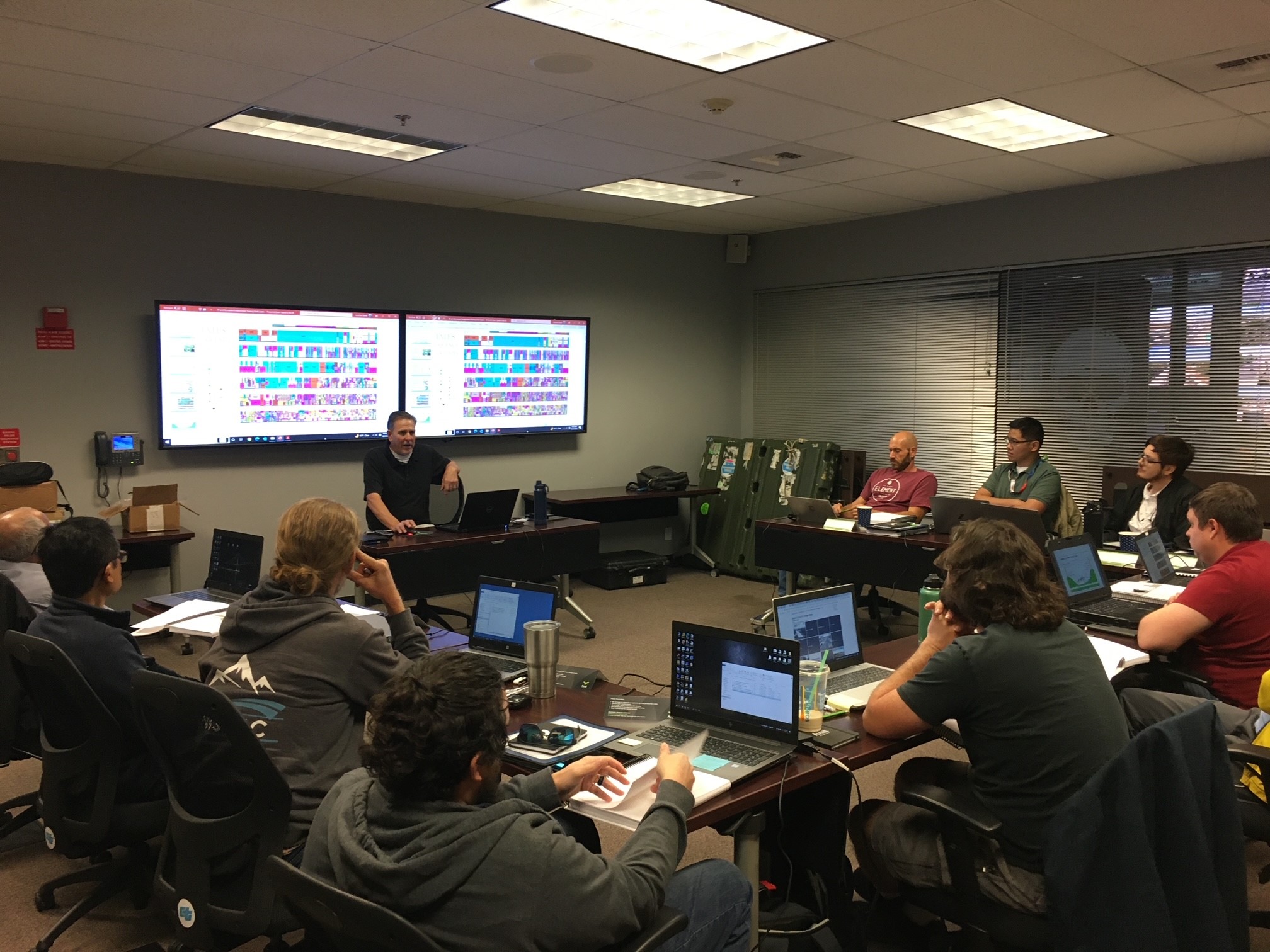
Photo by Sean Campbell
Phil Graham is an electrical engineer in Caltrans District 9. Headquartered in Bishop, District 9 is two counties in eastern California along the Nevada border. Arguably one of the more diverse Districts with respect to terrain, District 9 is very rural. Phil was a student in three of the Professional Capacity Building classes. What he learned in the courses has allowed District 9 to make use of technology they maybe wouldn't have been able to otherwise as well as make critical improvements to existing systems. Phil says:
“The training courses were quite helpful. The RF class helped expand on my knowledge of wireless communication systems, which we use extensively. The fiber optic class was both timely and challenging, as my knowledge was quite limited and D9 is about to receive 6 dark fibers from the Digital 395 Project that runs for hundreds of miles through the heart of our District. I'm now able to design the systems that will be required for us to actually use these 'free' fibers.
The classes have helped build my technical knowledge but perhaps just as importantly, they have helped foster working relationships. The other help to me is to see that there are ITS practitioners that pioneer new ways to improve the state of the practice in spite of the obstacles.”- Phil Graham, Transportation Engineer Electrical,
Caltrans District 9

Photo by Leann Koon |
Jeremiah Pearce is an ITS engineer and Chief of the Office of ITS Engineering and Support in Caltrans, District 2, in northern California. District 2 has been a leader in ITS deployments and a champion for many of the projects conducted through the Consortium. Jeremiah has been a student or PTAP observer for most of the PCB for Communications courses and had this to say about his experiences:
“What I like most about the PCB classes is that they are hands on and delivered by industry experts. The learning and experience is invaluable. The fiber optic course was very useful as I was using information and techniques in the field within weeks of taking the class.” - Jeremiah Pearce, Chief,
Office of ITS Engineering and Support, Caltrans District 2
Mike Beyer is also an ITS engineer for Caltrans District 2. He was a student in the September 2013 course on IP Networking Fundamentals and Usage as well as the 2015 Telco Wireless Fundamentals course. He says:
“The IP class was timely in that we are interested in testing some advanced telco provided services, like metro ethernet, and having a better idea of how the Telco’s handle those service types inside the Central Office makes our decision making process more informed.
The Telecom Wireless Fundamentals course was very timely and packed with solid information regarding the past state of the art, the currently emerging state of the art, and how that will affect our deployment of new cellular systems and the refresh of our existing systems. In addition, there were a plethora of best practice procedures for planning and deploying new systems. If that weren’t enough, the open discussions between students of what is working in the field and what isn’t, in the presence of a seasoned telecom wireless professional like Scott Baxter, added a depth of understanding to why some methods and specific devices were working and some not; they proved to be very useful discussions.”- Mike Beyer, ITS Engineer,
Caltrans District 2
Luis Torres is a Transportation Electrical Engineer in Caltrans District 10 headquartered in Stockton. District 10 is comprised of several counties in central California. Luis and a colleague participated in the optical fiber course in September 2012. He had this to say about how the course has influenced his work in Caltrans District 10:
“I was extremely pleased to learn the design process of the fiber optic systems. Having the calculation sheet provided by the instructor has improved my estimating immensely.
I would recommend this course to anyone within the public or private sector.
Recently, I assisted with the implementation of the first field elements via fiber optic within District 10.
Thank you for your continuous support.”- Luis M. Torres, Transportation Electrical Engineer,
Caltrans District 10
Michael Mullen is a transportation engineer electrical for Caltrans District 3 at the Sacramento Regional Transportation Management Center. Michael and a colleague participated in the optical fiber course in September 2012, the IP Networking Fundamentals and Usage course in 2013, and the 2015 Telco Wireless Fundamentals course. His work in District 3 has been impacted by what he learned in the courses as he describes below:
“The PCB Fiber Optic training course, I would strongly recommend to others. It has helped me understand the different terms of the fiber optic world, create effective and accurate cost analysis, how to test installed fibers, and communicate with colleagues about this technology.
The IP Networking training course, I would strongly recommend to anyone that wants to learn more about the history, where it is today, and where networking will most likely be in the future. It has helped me understand the different protocols, a proper way to understand subnets, and troubleshoot different potential IP networking problems.”- Michael Mullen, Transportation Engineer Electrical,
Caltrans District 3
Shima Afshari Wollman is a Traffic Engineer Electrical in Caltrans District 6 which has its headquarters in Fresno. She was a student in the IP Networking Fundamentals and Usage course in September of 2013. Right after the class she shared this with the project team:
“I‘d like to thank you … for the great training you organized. It was one of the best trainings I have had for a long time. The instructor was very knowledgeable. He had a great ability to transfer his knowledge and keep the class interesting and motivated. His class was way far from being a boring networking class. Not only did I learn a great deal about networking, I also enjoyed being in the class. Thank you again and please let me know next time you have a training as well organized as this one.” - Shima Afshari Wollman
One of the goals of the PCB training courses is to integrate relevant, practical examples and exercises in the course materials. Shima further commented on the IP networking class in this regard:
“The IP networking class was beyond my expectation. The instructor created a friendly and comfortable environment. Even though networking is not an easy subject to grasp quickly, he was able to transfer his knowledge in an understandable way by using everyday life examples.” - Shima Afshari Wollman, Traffic Engineer Electrical,
Caltrans District 6
Here are some comments from students about the value of the PCB
training courses:
"Course provided exactly what our jurisdiction was missing in terms of design to hands on."
"Very valuable training - will use in my job and instructor was excellent."
"The level of detail presented was excellent as was the subject matter."
"This course provides valuable information to engineers mostly working in design. I suggest our inspecting electrical engineers participate to get the maximum effect on our fiber projects."
"The course would be very beneficial to my coworkers and friends."
"We need more classes like this. It directly related to my job and will help me substantially. The objectives were pretty much met."
"The course met my needs for the type of applications used in my district and exceeded in other areas of coverage."
"The course was an extremely good primer for people with little knowledge of RF systems."
"This class taught me a lot of new topics relating to RF system design, more than I knew before. I would recommend this course to anyone interested in designing RF systems."
"[The course was] very applicable to understanding basic pit falls and 'behind the curtains' of the technologies of wireless."
"Very thorough and easy to understand. Would take another course again."
"The instructor covered both the practical and theoretical aspects well."
This is how students are directly applying what they learned
in the PCB courses to their job:
“Cooling system, power requirements, design, sizing of data center, etc.”
“Collect and log info such as power consumption for network / servers / video systems. This info should come in handy in future design / remodel.”
“Structured cabling - network design and probably I [will] get a chance to use grounding.”
“If we have a new data center I will be prepared to give some solid input to the design. Also how to manage a data center.”
“Rack layout, cabling, and grounding. Power and mechanical considerations.”
“Will be building out small telcom and refreshing main equipment room.”
“Yes, we will build TMC in the next five years.”
“Knowledge of TMC / Data Center materials / rules for design and development.”
“This course helps identify concerns for reliable data infrastructure that can be applied across the board in our ITS infrastructure.”
“Planning techniques. Documentation.”
“Power per row, cooling recommendations, future capacity planning, evaluating current capacities.”
“Data center upgrades for UPS and network room rearrangement.”
"Brought up two very immediate solutions to ongoing problems."
"I am in charge of CMSs (Changeable Message Signs), Highway Advisory Radio, and EMSs. To know how to configure routers and how to work with wireless will help me a lot."
"Application of wireless technology, and the tools and process of determining what is best for the application."
"Using signal strength and quality tools when implementing wireless in field locations."
"The understanding of antenna placement and diversity. General LTE/"4G" understanding of wireless encoding/frequency methods."
"Evaluation of LTE sites, deployment of LTE modems - tools presented in this training will help me in deployment of these modems and make informed decisions on type of antenna needed to boost poor signal locations."
"Location of antennas and types. Analysis of RF technology for cellular applications as it relates to different carriers."
"Knowledge of routing protocols and MPLS. Stronger Wireshark skills."
"IP subnet structuring, QoS, routing and overall depth of knowledge."
"IP addressing of various devices during configuration."
"Mostly construction inspection/acceptance."
"Using the OTDR and specifications for the design of fiber networks. Also, I will now be able to talk to the fiber experts with minimal misunderstandings."
"Single mode fiber concepts and fusion splice, system design. Everything I learned is applicable."
"OTDR testing, splicing, some design, troubleshooting."
"Design and testing / inspecting information."
"Fusion splicing, OTDR Testing, insertion testing, and much more."
"Selection of antenna and good understanding of the advantages and disadvantages of each antenna. I will use information learned from this class to troubleshoot sites that have bad or no signals. I may also be using some of the programs presented in class to do/help do point to point connection of several miles apart and also applying concepts of reflection, refraction, and fading learned from class."
"These days it is crucial to know this type of RF information to be able to work with adjacent local agencies and be able to communicate with them. Specifically in the areas of interconnecting signals. (Traffic signals)"
"Wireless communications design and maintenance."
"Adjust modulation type to increase fade margin. MIMO if applicable."
WSRTC HOME | IMPACT HOME | WSRTTIF IMPACT | PCB IMPACT | OSS IMPACT | PCB HOME

